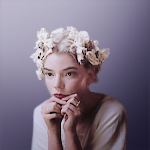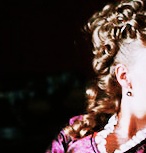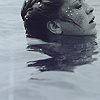-
.
R.I.P. ;_; vorrei tanto tornare alla torre munita di qualche fiorellino. . -
.
L'unica volta che sono stata a Londra ho visto la Torre solo da lontano - sob - la prossima volta farò un pellegrinaggio presso le tombe di quanta più gente possibile uwu . -
.
Io ci sono andata prima di nerdizzarmi per bene, infatti sapevo di Anne, della Howard e di Cromwell perché ero nel periodo di fissa seria coi Tudor mentre avrei potuto godermi di più anche altre *porzioni* del posto XD plus St Peter in Vincula era chiusa ;_; . -
.
Io credo di aver avuto voglia di nerdizzarmi DOPO la visita a Londra xD Ero circondata da tutta quella storia, e sono riuscita a godermela solo in piccola parte per via della mia ignoranza, per questo ho deciso di recuperare xD
Noticina storica: pare che Elizabeth sia stata liberata dalla Torre di Londra proprio il 19 maggio, anno 1554 ç__ç. -
.CITAZIONENoticina storica: pare che Elizabeth sia stata liberata dalla Torre di Londra proprio il 19 maggio, anno 1554 ç__ç
NOOOOO piango ;__;CITAZIONEIo credo di aver avuto voglia di nerdizzarmi DOPO la visita a Londra xD Ero circondata da tutta quella storia, e sono riuscita a godermela solo in piccola parte per via della mia ignoranza, per questo ho deciso di recuperare xD
Ma questo capita spesso vero? XD solo ora capisco perché mio babbo insisteva che io e mio bro ci documentassimo sui posti che visitavamo. Ma io ho davvero grossi problemi a ricordarmi le cose, se non ho un interesse particolare i nomi per me sono solo nomi.. -
.
 CITAZIONEAlla luce degli ultimi documenti resi pubblici dell'Archivio Segreto Vaticano una vicenda su Anna Bolena, la seduttrice, la dominatrice, l'astuta. Enrico VIII, re d'Inghilterra, perde la testa per lei: è giovane, intraprendente, colta... Anna arriva a corte come dama di compagnia della regina Caterina di Aragona. Il re le scrive lettere d'amore infiammate che, pur nello stile cavalleresco, bruciano di passione. Per Anna entra in conflitto con il Pontefice, manda a languire l'infelice Caterina. Un amore che finirà in tragedia. Anna, il suo re e il gioco politico che fa da sfondo alla loro storia continuano ancora ad affascinare il grande pubblico. Ma le lettere - e non solo - raccontano molto più delle centinaia di libri, romanzi e fiction che hanno scritto e fantasticato su queste vicende. Attingendo all'Archivio Segreto Vaticano, che conserva un mazzo di missive di Enrico ad Anna, Dal Bello ricostruisce la relazione tra la Bolena ed il re, storia che avrà conseguenze decisive per il Paese: lo scisma tra l'Inghilterra e Roma, ma anche il regno "glorioso" di Elisabetta, la "figlia bastarda" della Bolena.
CITAZIONEAlla luce degli ultimi documenti resi pubblici dell'Archivio Segreto Vaticano una vicenda su Anna Bolena, la seduttrice, la dominatrice, l'astuta. Enrico VIII, re d'Inghilterra, perde la testa per lei: è giovane, intraprendente, colta... Anna arriva a corte come dama di compagnia della regina Caterina di Aragona. Il re le scrive lettere d'amore infiammate che, pur nello stile cavalleresco, bruciano di passione. Per Anna entra in conflitto con il Pontefice, manda a languire l'infelice Caterina. Un amore che finirà in tragedia. Anna, il suo re e il gioco politico che fa da sfondo alla loro storia continuano ancora ad affascinare il grande pubblico. Ma le lettere - e non solo - raccontano molto più delle centinaia di libri, romanzi e fiction che hanno scritto e fantasticato su queste vicende. Attingendo all'Archivio Segreto Vaticano, che conserva un mazzo di missive di Enrico ad Anna, Dal Bello ricostruisce la relazione tra la Bolena ed il re, storia che avrà conseguenze decisive per il Paese: lo scisma tra l'Inghilterra e Roma, ma anche il regno "glorioso" di Elisabetta, la "figlia bastarda" della Bolena.
x
Dal Bello ha scritto anche un libro sui Borgia un paio d'anni fa.. -
.
Dalla prefazione di Ives, adoro: CITAZIONEYet although we cannot recover Anne in sharp focus, she does come through as more than two-dimensional, more than a silhouette. She was the most influential and important queen consort this country has ever had. Indeed, Anne deserves to be a feminist icon, a woman in a society which was, above all else, male-dominated, who broke through the glass ceiling by sheer character and initiative.
How one would have felt about her is another matter. Captivating to men, Anne was also sharp, assertive, subtle, calculating, vindictive, a power dresser and a power player, perhaps a figure to be more admired than liked. But against that is Anne’s greatest distinctiveness, something she shares with only one other English queen: she married for love. Her relationship with Henry was deeply personal in a way kings had risked only once before, and never did again until the twentieth century.
The couple’s attempt to have an affectionate marriage, with perceptible hints of modernity in the context of a Tudor court, explains much of the life and death of Anne Boleyn. It also means that the more we understand Anne, the more we understand the greatest puzzle of the Tudor century, the personality of her husband Henry; as the saying goes, ‘it takes two to make a marriage.’. -
.
La Royal Collection ha ufficialmente catalogato questo disegno di Holbein come "Anna Bolena".  CITAZIONEQueen Anne Boleyn (c.1500-1536)
CITAZIONEQueen Anne Boleyn (c.1500-1536)
c.1533-36
Hans Holbein the Younger
Qui l'articolo e qui la pagina della Royal Collection.
Edited by ‚dafne - 18/2/2016, 14:17. -
.
Oooh non lo sapevo, grazie! Non ricordo dove avevo letto che fosse uno schizzo di Anna in gravidanza, forse nel libro della Fraser, ma sapevo delle divergenze. CITAZIONEThe second drawing, also identified by inscription, is in the Royal Collection (Fig. 37). It appears, on first inspection, to be a most unqueenly portrait. The sitter wears an undercap, a night gown and a simple chemise. The presence of a Wyatt coat of arms on the reverse of the drawing has led some to incorrectly suspect the sitter is a member of that family.6 However, I would like to restate here an earlier suggestion that the sitter is, in fact, Anne Boleyn.7
The most important evidence is the inscription, top left, ‘Anna Bollein Queen’. Similar inscriptions appear on the majority of Holbein drawings in the Royal Collection. The inscriptions themselves are not contemporary to the drawings, but we know from an early reference (1590) that they derive from original identities ‘subscribed by Sr John Cheke Secretary to King Edward the 6’,8 when the ‘great booke’ as it was known, belonged to the Earl of Arundel. Cheke (Fig. 42) was one of the bright brains of the Tudor court. He would have known most of Holbein’s sitters if not on personal terms, then at least visually. In 1544 he became tutor to Edward VI. It was probably then that Cheke identified the sitters for the benefit of the young prince, who we know took a keen interest in the book. Cheke began his career at court under the patronage of none other than Anne Boleyn. It seems inconceivable that he would get Anne’s identification wrong. [...] On simple probability alone, the chances of the inscription being erroneous are slim. And, as mentioned above, Anne is one of the sitters Cheke was least likely to get wrong. Similarly, one would struggle to see why, if a later inscriber was casting around for a portrait to call Anne among the drawings, he would have alighted on an image that least resembles the modern conception of a queen. I do not believe that the likeness in Fig. 37 is totally dissimilar to the later portraits of Anne, such as that exhibited here. The raised nose, long face and slightly prominent jaw are comparable. The chin in the drawing is perhaps swollen, and would accord with Anne’s alleged facial misfortune. And the unusually simple costume is another argument in favour of Anne, for only a woman of the highest rank would have taken such a liberty in court circles. Privacy and royalty rarely went together. The Queen’s Privy Chamber was in fact a rather public place. Henry too was known to receive visitors ‘in a nyght gown’.15
There is no conclusive proof that the sitter in the Windsor drawing is Anne. And yet the case in favour of it being her is strong. At the very least, we should view with a healthy scepticism those later portraits that show Anne as a dark and vaguely frightening figure.
Devo dire che a me sembra probabile sia lei perché concordo con la parte che ho grassettato!. -
.
Puo' essere che sia in gravidanza, questo spiegherebbe il viso molto pieno anche se qui parlano di 'facial misfortune'. CITAZIONEThe chin in the drawing is perhaps swollen, and would accord with Anne’s alleged facial misfortune.
Detto ciò: il naso e gli occhi scuri mi convincono ma i capelli biondi molto di meno, anche se sono consapevole che esiste un dibattito notevole sul colore dei capelli di Anne xD. -
.CITAZIONEanche se sono consapevole che esiste un dibattito notevole sul colore dei capelli di Anne xD
Sai che io l'ho scoperto solo col libro della Bordo? Cioè magari se ne discuteva in altri ma non me lo ricordavo, per parte mia ho sempre dato per scontato che quel "brunetta" significasse che banalmente era bruna.SPOILER (clicca per visualizzare)
D'altronde:
-carnagione olivastra
-occhi neri
Quante probabilità ci sono che fosse bionda o rossa? L'unica bionda con gli occhi scuri che mi viene in mente è Leighton Meester. Al massimo posso pensare che si schiarisse i capelli!. -
.
ODDIO LO SPOILER :°°°
Detto ciò, anchio pensando ad occhi e carnagione ho sempre dato per scontato che avesse i capelli castani se non proprio neri. Forse, la butto lì, Holbein ha iniziato a stendere l'oro per avere una base molto luminosa su cui poi aggiungere altro colore oppure semplicemente sfumare, dato che è un disegno/schizzo? In fondo ci sono delle sfumature più scure in due zone *svarioni* :°°°. -
.
I lineamenti sembrano coincidere con altri ritratti di Anne, ma coi capelli proprio non ci siamo, come avete già scritto le possibilità che con occhi e carnagione scura fosse bionda sono quasi inesistenti. Insomma, potrebbe starci ma nonsono del tutto convinta xD
Btw Ives aveva scartato questo schizzo come ritratto di Anne perchè per altri ritratti della stessa collezione era stata provata un'identificazione sbagliata, per cui la storia che sia stato Cheke a dare un nome a questo e ad altri ritratti potrebbe essere spuria.. -
.
C'è una parte dell'articolo di sopra che prima avevo lasciato fuori ma parla proprio di quegli errori di identificazione, la riporto ora: CITAZIONEMost authorities have dismissed the validity of the ‘Anna Bollein’ inscription due to other apparent inconsistencies and errors in the Cheke identifications.9 However, recent research suggests they may be more accurate than is assumed. K. T. Parker’s excellent catalogue of the Windsor drawings, published in 1945, lists a total of sixty four drawings, then attributed to Holbein, which bear inscriptions derived from Cheke’s original annotations.10 Of these, only nine identifications are seriously questioned, among them the drawing of Anne. And of these nine, only two sitters, I suggest, can be certainly erroneous. The most obvious Cheke error was thought to be a drawing inscribed ‘Iohn Colet Dean of St Paul’s’ [Parker 59]. Colet died in 1519, long before Holbein arrived in England. However, Susan Foister has shown that Holbein’s drawing was taken from a bust by Torrigiano. Holbein was clearly willing to draw subjects without life sittings, as, for example, his oil portrait of Melanchthon shows [Niedersachsisches Landesmuseum, Hanover]. Until recently it was believed that Melanchthon sat to Holbein, but, as John Rowlands demonstrated, this cannot be the case.11 It is possible, therefore, that Holbein first sketched the likeness from his imagination, drawing from a number of different sources. If so, we cannot any longer rule out the inscription on a drawing at Windsor inscribed ‘Phil. Melanchton’ [Parker 68] on the grounds that it does not exactly replicate the final painting. The likeness between and the finished oil is close enough – and the sitter is clearly continental, to judge from his hat.
Another apparent Cheke error has been assumed to be the misidentification of a drawing inscribed ‘The Lady Mary after Queen’ [Parker 41] (Fig. 40). On first inspection it seems unlikely that the sitter is Mary Tudor. The pretty carefree sitter in Holbein’s drawing seems so unlike that the sour prude seen in Antonio Mor’s portraits of Mary (Fig. 41). But I believe that the Holbein drawing certainly is Mary. A study of the jewellery allows a positive identification to be made. The sitter wears jewellery also seen in Master John’s portrait of Mary of 1544 [NPG 428, Fig. 4], in which the likeness, too, is similar. Unfortunately the central jewel in the drawing is too rubbed to certainly identify, but the rough outline is closely comparable to the jewel seen at Mary’s neck in the John portrait. The jewel can be found in Mary’s inventory of Jewels; ‘Itm A flower wt five great Diamonds, ij rubies, oon Emerawde, and a great ple pendunte’. The unusually large pearls around Mary’s neck are also identical with those in the John portrait, and these too can be found in Mary’s inventory. They are, depending on how she wore them, either; ‘Itm a lace of great ples for hir graces Necke conteyning lxvij. Ples’, or, ‘Item a lace for her to goo once a bought her grace necke conteynig xxvj. greate perle’.12
Three further previously questioned Cheke identities are; ‘Edward Prince of Wales’ [Parker 71], ‘Ormond’ [Parker 23], and ‘The Dutchess of Suffolk’ [Parker 56]. But these need not challenge Cheke’s accuracy either. The first, Edward, we can confidently prove is correct, for the same face pattern can be found on a rare series of portraits of Edward at the age of about four (Fig. 43). The portraits were almost certainly taken from Holbein’s drawing, and have always been accepted as Edward. In the painted version Edward holds a Lancastrian rose. The drawing of ‘Ormond’ has been shown not be Thomas Boleyn, as was presumed, but James Butler, ninth Earl of Wiltshire & Ormond,13 thus clearing up any confusion over the sitter’s dates. Finally, there has been some confusion which ‘Dutchess of Suffolk’ Holbein shows, an issue discussed below in some detail by Alisdair Hawkyard.
This leaves just two erroneously inscribed drawings from the More family group portrait. The first is ‘The Lady Barkley’ [Parker 4] but is in fact Elizabeth Dauncey, More’s daughter. The second is inscribed ‘Mother Iak’ [Parker 8], but shows Margaret Giggs, More’s adopted daughter. We can surely forgive Cheke these errors, for the drawings date from Holbein’s first trip to England between 1526–8, well before Cheke came to court.14
Which leaves us with Anne. On simple probability alone, the chances of the inscription being erroneous are slim. And, as mentioned above, Anne is one of the sitters Cheke was least likely to get wrong.
x. -
.
Questa parte non l'avevo letta, grazie <3
Certo se l'identificazione è corretta questo è il migliore ritratto di Anne di cui disponiamo, sia per qualità sia perchè non è una copia fatta anni dopo la sua morte, ma è stato realizzato quando lei era ancora in vita ;_;.
Anna Bolena (Anne Boleyn) |








